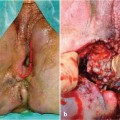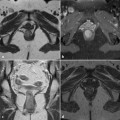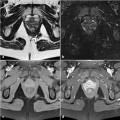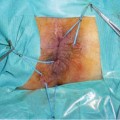Fig 7.1
HSV proctitis
7.5 Syphilis
Syphilis is caused by the spirochete Treponema pallidum. The typical presentation is a single painless anal ulcer (chancre), although other symptoms may be present as well, such as discharge, bleeding, significant pain, and itching.
Secondary syphilis can occur 6–8 weeks after healing of the initial ulcer, especially if the patient was not treated. This stage is characterized by a mac- ulopapular rash, usually located on the palms of the hands and soles of the feet. Genital and anorectal condylomata localize near the initial chancre. There are also systemic symptoms of fever, night sweats, and weight loss [1, 5].
7.6 Lymphogranuloma Venereum
Lymphogranuloma venereum (LGV) is caused by Chlamydia trachomatis serotypes L1-L3. Serotype L2 was implicated in a recent outbreak. The symptoms include anal ulceration at the site of inoculation (if present) and painful inguinal lymphadenopathy, also referred to as “buboes”. Among patients with LGV, 25% will not develop lymphadenopathy. During a recent outbreak of LGV, most patients had almost exclusively rectal symptoms [2, 5].









